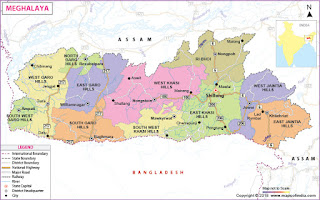Meghalaya
(25° 02' - 26° 07' N and 89° 49' - 92°50' E) is literally ‘the abode of the
clouds’. It became an autonomous State on April 2, 1970, and was declared a
State of the Indian Union on January 21, 1972. The State has a geographical
area of 22,42,900 ha (0.7% of the country’s geographical area).
Topographically, Meghalaya is a plateau except for narrow strips of plains in
the northern, western, and southern parts. Shillong, the capital, is situated in
the center of a high plateau.
The elevation ranges from less than 100 m to 1961
m. The highest peak is Laitkor Peak (1961m). Nokrek is the highest peak in
the Garo Hills.
As per the Census records, the State is the homeland of three
of India’s ancient hill communities – the Khasis, the Jaintias, and the Garos. Khasi is spoken by the Khasis and Jaintias, while Garo Hills is the homeland of
the Garos who prefer to call themselves ‘Achik’.
The western part of the State
is warmer where the temperature ranges between 120 C to 330 C.
The central upland is relatively cooler where the minimum temperature goes down to
20 C and the maximum temperature is around 240C.
The
average annual rainfall in the State varies from 4,000 mm to 11,436
mm. Cherrapunji (Cherapunjee) and Mawsynram in Meghalaya are well-known as
the highest rainfall spots in the world. Cherrapunji had the
distinction of recording the highest rainfall in the world, 24,461 mm, in
1860-61 (Choudhury 2003).
The major rivers of Meghalaya include the
Simsang, the Manda and the Ganol in the Garo Hills and the Jadukata, the Umiam,
the Umtrew, the Lubha, and the Kopili in the Khasi and the Jaintia
Hills. The total human population of Meghalaya is 2.31 million,
which is 0.2% of India’s population (2001 Census). Nearly 80% of the population
lives in rural areas.
Meghalaya’s population is predominantly tribal
(85.5%). As per the 2001 Census, the population density of the State
is 103 persons per sq. km.
There are
different legends, beliefs and findings of the Khasis, Jaintias and Garos.
It is said that Khasis were the earliest immigrants who made their way across
northern Myanmar to Khasi in the plain of East Assam where they established a new
center. Khasis linguistically represent the Mon-Khmer speeches spoken in
South-East Asia.
The Khasi, Garo, and Jaintia tribes each had their own kingdoms until they came under British administration in the 19th century.
Eventually, the British incorporated Meghalaya into Assam in 1835. After its
Independence in 1947, Meghalaya was given autonomous status within Assam.
However, Meghalaya was not satisfied with the arrangement and started the peaceful and constitutional struggle for more independence.
The turning point
in their struggle came when Assam introduced Assamese as the state language, a
language unknown to the tribes of Meghalaya.
The Centre recognized their plight
and their right to a state of their own. In the year 1972, Meghalaya became a
full-fledged state in the Republic of India.
All three major ethnic tribal groups, namely, the Khasis, Jaintias and the Garos also have their own traditional political institutions that have existed for hundreds of years.
These political institutions were fairly well developed and functioned at various tiers, such as the village level, clan level and state level. In the traditional political system of the Khasis, each clan had its own council known as the Dorbar Kur which was presided over by the clan headman.
The council or the Dorbar managed the internal affairs of the clan. Similarly, every village had a local assembly known as the Dorbar Shnong, i.e. village Durbar or council, which was presided over by the village headman.
The inter-village issues were dealt with through a political unit comprising adjacent Khasi Villages. The local political units were known as the raids, under the supreme political authority known as the Syiemship.
The Syiemship was the congregation of several raids and was headed by an elected chief known as the Syiem or Siem (the king). The Siem ruled the Khasi state through an elected State Assembly, known as the Durbar Hima.
The Siem also had his mantris (ministers) whose counsel he would use in exercising executive responsibilities.
Taxes were called pynsuk, and tolls were called khrong, the
latter being the primary source of state income. In the early 20th century, Raja
Dakhor Singh was the Siem of Khymir.
The Jaintias also had a three-tier
political system somewhat similar to the Khasis, including the Raids and the
Syiem. The raids were headed by Dolois,
who was responsible for performing the executive and ceremonial functions at
the Raid level. At the lowest level were the village headmen.
Each
administrative tier had its own elected councils or durbars. In the traditional
political system of the Garos a group of Garo villages comprised the A·king.
The king functioned under the supervision of the Nokmas, which were perhaps
the only political and administrative authority in the political institution of
the Garos.
The Nokma performed both judicial and legislative functions. The
Nokmas also congregated to address inter-A·king issues. There were no
well-organized councils or durbars among the Garos.
To study more about Meghalaya some books recommendation given below. These are
also used as references for this article. So, I highly recommend you go through
these books. For details click the book title.
Sources:

